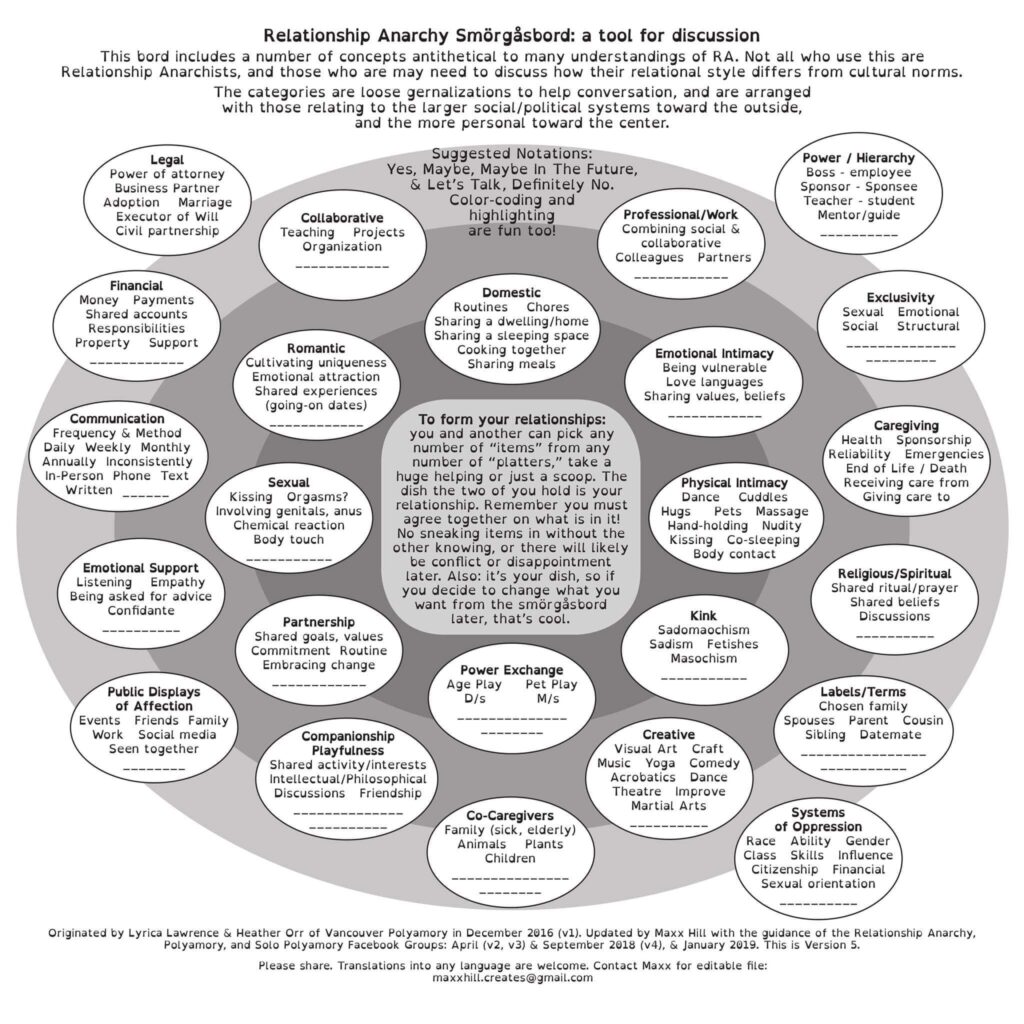Introduction
In ethical non-monogamy, relationships don’t always come with a neat label. You might find yourself in a connection that feels important, but doesn’t quite fit into a predefined category—a relationship that doesn’t follow any familiar blueprint. We might call these ambiguous bonds. Whether you’re in one yourself or watching your partner navigate one, ambiguity can bring a unique mix of opportunity and challenge.
These undefined connections allow for a natural evolution, but the freedom to “just see where things go” can also bring its own kind of uncertainty. How do you figure out where you stand when things are deliberately left open? How do you express your needs without a clear sense of what the relationship is? In this article, we’ll explore the complex emotional landscape of ambiguous bonds, why they come up, and how to navigate them with a little more ease. We’ll also talk about practical tools, like the Relationship Anarchy Smorgasbord, and strategies for growing trust and communication in relationships that resist simple definitions.
The Complexity of Ambiguous Bonds
Not every relationship in non-monogamy fits into tidy boxes. You might have a connection that feels significant but doesn’t match conventional labels like “romantic” or “platonic.” These ambiguous bonds carry weight, even though they aren’t fully defined.
One of the powerful things about ambiguous bonds is the freedom they offer. They let you explore a connection without immediately pinning it down. But that same openness can cause confusion, not just for the people in the bond, but for others around them as well. Ambiguity doesn’t stay neatly contained—it ripples out, often making other partners wonder where they fit in.
If you’re watching a partner engage in one of these undefined connections, it can stir up some difficult questions. What is this relationship? Where do I stand in relation? It’s not uncommon to feel unsettled when the boundaries aren’t clear. Sometimes, the hardest part is sitting with the unknown, especially when there’s no easy answer to the question, “What is this?”
One approach is to clarify what the relationship isn’t. Maybe it’s not romantic, or it’s not sexual, or certain commitments aren’t part of the picture. That clarity can help – but only if it works for you. For some, this kind of definition might begin to offer a foundation that makes the ambiguity less overwhelming.
These kinds of bonds often emerge because people want space to explore without feeling boxed in. That flexibility is part of their appeal. But it’s important to acknowledge that freedom can sometimes feel destabilising, particularly if there isn’t clear communication about what everyone is comfortable with.
The Role of Personal Values and Expectations
Navigating ambiguous bonds doesn’t just depend on the relationship itself—it has a lot to do with your personal values and expectations. Some people embrace ambiguity with open arms, thriving in relationships that aren’t pinned down by labels. They see it as a chance to let connections evolve naturally.
But not everyone feels that way. If you crave emotional security or prefer a bit more structure, not knowing where you stand—especially in comparison to someone else—can trigger feelings of unease. It’s important to recognise that how you experience ambiguity and how your partner experiences it might be very different, and those differences can lead to tension if they’re not talked about.
Your past experiences also play a role. Maybe you’ve been in a situation where ambiguity led to hurt, and that’s why you feel the need for more clarity now. Or perhaps you’ve always valued independence in your relationships, and the idea of labelling things too soon feels restrictive.
Understanding your expectations and communicating them clearly, both to yourself and your partners, is key. It’s about advocating for what you need—whether that’s more clarity, more reassurance, or more space. And it’s equally important to recognise that your partner might need different things. That’s why open, ongoing communication is so essential.
There’s no one-size-fits-all way to manage ambiguity. But by staying in touch with your values and being honest about your needs, you can find a balance that works for everyone involved. Just remember, it’s okay to want more definition, and it’s okay to be comfortable with less. The most important thing is understanding those needs and talking openly about them.
Navigating Uncertainty in Relationships
Ambiguity and uncertainty go hand in hand. And while some people thrive in undefined spaces, others find them difficult to manage. So, how do you deal with the emotions that come with it—whether you’re in the ambiguous bond or watching it unfold from the outside?
- Open Communication is Key Uncertainty is much harder to deal with when communication breaks down. Honest conversations about how the ambiguity is making you feel are crucial. You don’t need to define the relationship, but you do need to talk about how the lack of definition is impacting you.
- Boundaries are Still Important Just because a relationship doesn’t have a clear label doesn’t mean there shouldn’t be boundaries. In fact, boundaries might be even more important here. When the relationship itself is undefined, setting boundaries around what you need to feel secure can help.
- Stay Present It’s easy to spiral into anxiety about where an ambiguous relationship is headed. Instead of fixating on the future, try to focus on what the connection is bringing to your life right now. What are you getting from it today?
- Seek Support When You Need It Managing ambiguity can be hard, and there’s no shame in asking for help. Whether it’s talking to a trusted friend or finding a polyamory-friendly therapist, outside support can give you the clarity and perspective you need.
Coping with Ambiguity
Ambiguity can be a rollercoaster, but there are ways to manage the emotional ups and downs:
- Self-Reflection Get clear on what you’re feeling. Are you anxious about where the relationship is going? Are feelings of jealousy or insecurity creeping in? Understanding your emotions is the first step in addressing them.
- Talk About It If ambiguity is making you feel unsettled, don’t be afraid to bring it up with your partner(s). Ambiguity is hardest to deal with when it’s not acknowledged, so even if the conversation feels uncomfortable, it can relieve some of the tension.
- Set Flexible Boundaries Boundaries are important, especially in ambiguous bonds. Flexibility is key—boundaries that protect your emotional space while allowing the relationship to evolve are often the most effective.
- Focus on the Present Instead of worrying about where the relationship is headed, ask yourself what it brings to your life right now. Focusing on the present can help ground you.
- Don’t Go It Alone Sometimes, ambiguity feels overwhelming. Talking things through with someone outside the situation can offer a fresh perspective. Whether that’s a therapist, a friend, or a polyamorous community, support can make a big difference.
Using the Relationship Anarchy Smorgasbord
Navigating ambiguity doesn’t mean you’re without tools. One great resource for mapping out what a relationship looks like—especially when it’s hard to define—is the Relationship Anarchy Smorgasbord.
- Explore What You Value The Smorgasbord helps you map out the different kinds of intimacy and connection in your relationships. Rather than relying on traditional labels, it encourages you to explore categories like emotional support, intellectual connection, and shared activities.
- Clarify Boundaries Going through the Smorgasbord can help you and your partner(s) clarify what you’re comfortable with and where you might need more structure.
- Revisit Over Time Relationships change, and so do your needs. Revisit the Smorgasbord periodically to check in and update your boundaries and preferences as things evolve.
- Embrace the Process The Smorgasbord isn’t about rigid definitions—it’s a tool for dialogue and exploration. It’s there to help you talk about your connection without squeezing it into a predefined box.

Fostering Transparency and Trust
If there’s one thing that makes ambiguity easier to manage, it’s trust. And trust comes from transparency. Even when things are undefined, being open about your feelings, uncertainties, and boundaries builds the trust that keeps a relationship thriving.
- Be Transparent, Even When It’s Hard It can be tempting to avoid tough conversations because you don’t know all the answers, but honesty—even when uncomfortable—helps maintain trust.
- Build Trust Gradually Trust takes time, especially in ambiguous bonds. It’s built through consistent communication and showing up for each other.
- Check-in Regularly Regular check-ins can keep communication flowing and make sure everyone is on the same page, even when things are undefined.
- Embrace the Unknown Together Ambiguity doesn’t have to mean confusion. With trust and transparency, you can navigate the unknown together and explore the relationship without fear.
Tips and Takeaways
Here are a few practical steps for navigating ambiguous bonds:
- Check-in Regularly: Schedule conversations with your partner(s) to discuss how you’re feeling about the relationship.
- Use the Smorgasbord: Map out the different aspects of your relationship to clarify what matters most.
- Set Flexible Boundaries: Boundaries matter, even in undefined relationships. Protect your emotional space.
- Focus on the Present: Don’t worry too much about the future—stay grounded in what the relationship is bringing to your life right now.
- Be Honest About Your Needs: Whether you need more clarity, reassurance, or space, communicate openly.
- Seek Support: Don’t hesitate to reach out to friends, communities, or a therapist for support.
Additional Resources
- Relationship Anarchy Smorgasbord
- Polysecure: Attachment, Trauma and Consensual Nonmonogamy by Jessica Fern
- The Ethical Slut: A Practical Guide to Polyamory, Open Relationships & Other Adventures by Dossie Easton and Janet W. Hardy
Share this content:

Comments are closed